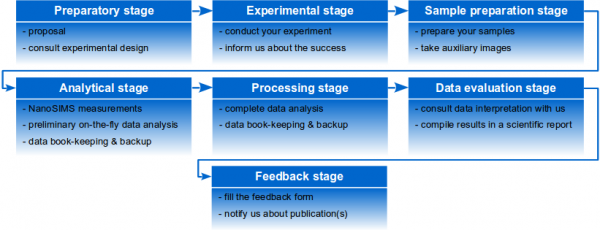Sidebar
Table of Contents
Flow of the NanoSIMS analysis
To allow optimisation of the flow of NanoSIMS measurements at our facility, we ask users to follow these generic steps.
Early preparatory stage
- Apply for NanoSIMS measurement time
- Write a short proposal and send it to us for evaluation and comments
- Consult us about the experimental design
- what is possible to measure with NanoSIMS
- which additional (possibly parallel) analyses would you like to perform on your samples
- how should the samples be prepared
- how many replicates will be realistic
- when is the realistic time for the NanoSIMS analysis (check schedule)
- how long will the analysis take
- how much will it cost
Experimental stage
- Conduct the experiment
- Inform us about the success of your experiment
- to initiate more detailed scheduling
- to modify scheduling
Sample preparation stage
- Prepare your samples
- on filters, glass-slides, Si-wafers, embedded in a resin and polished, etc., adhering to these basic guidelines
- if you plan to study specific minerals/elements, prepare your own standards (some standards are available at Utrecht University)
- if necessary, deposit a thin conducting coating (e.g., Au) on the samples (can be done at Utrecht University)
- Organize your samples
- make high-resolution images of your whole samples (they can be any kind of images, e.g., microscope images, TEM/SEM images); these will be used for quick navigation through the sample while it is in the NanoSIMS instrument
- note co-ordinates of easily visible “landmarks” on your samples (see example)
- note co-ordinates of regions of interest that are to be analyzed with NanoSIMS
- label your samples and regions of interest
- compile a detailed measurement protocol (what should be measured and in which order of priority)
- consult the detailed measurement protocol with us
- familiarize yourself with this spreadsheet, which you will be filling during the NanoSIMS measurements and analysis to help us keep track of what has been measured
- Bring/Send to us the samples together with the annotated images
Analytical stage
- If possible, attend the NanoSIMS analysis
- to guide the operator
- to understand the effort involved
- to make more detailed notes about the measurement
- If personal attendance is not possible, stay connected to a “hot-line”

- in this case the operator will keep notes about the measurement
- Do preliminary processing/analysis of the generated data (see note below)
- either “on-the-fly”, or at least at the end of each measuring day
- with the software and computer provided, such analysis is possible as soon as the measurement of a particular region of interest has finished.
- Store and backup your raw data, log files and other notes gathered during the measurements
- on our server, to which you will have a password protected access
- in your own storage space
- Link sample labels from the measurement protocol generated by you with filenames assigned during the NanoSIMS measurement
- remember, our system for keeping track of what has been measured may differ from yours, and there is nothing worse than a bunch of raw data files with no meaning assigned to them
Data processing and analysis stage
- Analyze all your raw data
- the Look@NanoSIMS software that we provide helps you doing that in an easy and fast way
- remember: even if a particular measurement did not seem to produce scientific value for you, it may have produced a useful know-how for us
- Keep a backup of the processed and analyzed data
- on your own storage space
- on our server, to be used as a point of reference when specific questions about data analysis arise
- Contact us if you have specific needs for data processing/analysis
- we are quick to implement new features to the program
Data evaluation stage
- Consult the results and your interpretation of them with us
- to validate that you have done the processing and analysis correctly
- to ensure that you are not over-interpreting the data
- Compile data in a scientific report
Feedback stage
- Fill this feedback form, save it as PROJECT_ACRONYM-Your_Name-Feedback.doc, and e-mail it to us
- constructive criticism and suggestions for improvement are always welcome
- we ask you to do so within 3 months after the measurements were finished
- Notify us when the scientific report was published - it will feel good for us too!
Note regarding data processing and analysis
We recommend that you familiarize yourself with the data processing and analysis software before your scheduled measurement time. After all, unless you explicitly want us to do the complete analysis for you, it will be you who will need to analyze all the data.
To learn about the software, schedule a day or two for a crash-course, or sign up to workshops that will be scheduled in regular intervals once a critical mass of users has been established.
The logic behind this recommendation is simple but powerful: doing preliminary analysis of the generated data “on-the-fly” will not only give you peace of mind that everything is working as you hoped for, but will also enable better decision-making about the measurement priorities! By looking at your samples with the unprecedented detail offered by NanoSIMS, you will very likely discover something completely unexpected. In such a situation, being able to improvise based on a last-minute information is often as important as being systematic.


